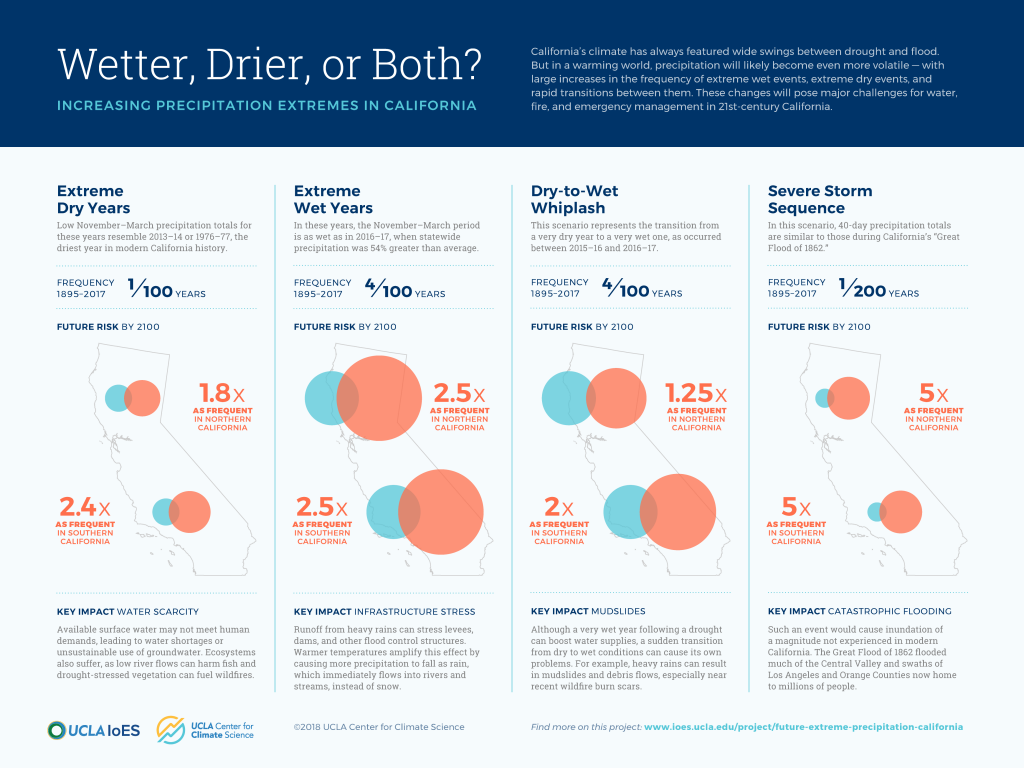Increasing precipitation whiplash in twenty-first century California
Note: This special Weather West article focuses on new peer-reviewed scientific research that my colleagues and I recently published in Nature Climate Change.
Overview: small shift in average precipitation, but big increase in extremes
Previous studies have found that future changes in California’s overall average annual precipitation are likely to be fairly modest, even under rather extreme global warming scenarios. Most climate models suggest that the boundary between mean wetting (in the already moist mid-latitude regions to the north) and mean drying (in the already arid subtropics to the south) in a warming world will likely fall somewhere over California—which increases uncertainty regarding whether the region will become slightly wetter or slightly drier on average. The notion that California’s average precipitation might not change much in the future is actually somewhat surprising, as there is high confidence that other “mediterranean” climate regions on Earth will experience progressively less precipitation as the world warms and the region of stable subtropical influence expands. As we demonstrate in our new research, however, these small shifts in average precipitation mask profound changes in the character of California precipitation. We find that the occurrence of both extreme wet and extreme dry events in California—and of rapid transitions between the two—will likely increase with atmospheric greenhouse gas concentrations. The rising risk of historically unprecedented precipitation extremes will seriously test California’s existing water storage, distribution, and flood protection infrastructure.
California, a land of climate extremes—past, present, and future
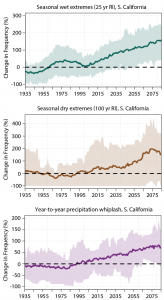
California is certainly no stranger to drought and flood. Not only have weather and climate extremes profoundly shaped the history of the Golden State, but there is considerable paleoclimate evidence that the region presently known as California has experienced great swings between wet and dry for thousands of years. The region experiences a deep “seasonal drought” virtually every summer; during winter, a large fraction of annual precipitation falls over the course of just a handful of heavy precipitation days associated with “atmospheric river” storms. And in addition to these large seasonal and year-to-year swings in precipitation, California is also a place of great geographic diversity: with its long coastline, vast Central Valley, and numerous mountain ranges of varying heights and orientation, the state is home to an incredible array of microclimates. As most longtime residents can attest, California climate is remarkably variable—not only over time, but also from place to place within the state.
California’s propensity toward meteorological extremes is key in understanding the kinds of changes that are likely to occur here in a warming world. As most of us already know, global climate is presently changing at a rate faster than has occurred in thousands of years, almost exclusively due to the emission of greenhouse gases (like carbon dioxide) into the Earth’s atmosphere. But the Earth is not warming at the same rate everywhere, and regional differences are subject to considerably more scientific uncertainty than the overall global warming trend. That’s especially true for many of the complex meteorological phenomena that we care most about: the dramatic storms, floods, heatwaves, and droughts that tend to have the largest impacts upon human lives, economies, physical infrastructure, and the environment.
To address this challenge, my colleagues and I set out to assess how the increasing emission of greenhouse gases will affect California precipitation. Rather than considering average precipitation, as most previous studies have, we instead focused on wet and dry precipitation extremes specifically using a large ensemble of climate model simulations. I discuss our findings in detail below; if you’re interested in our methods, I encourage you to read the underlying paper.
Large increase in very wet years; more modest increase in dry years
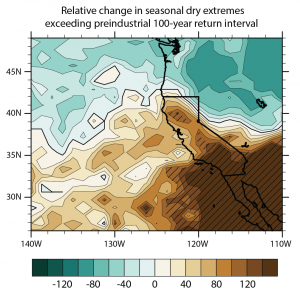
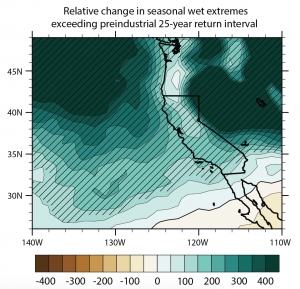
We find that most of California will likely experience a 100 – 200% increase in the frequency of very wet November-March “rainy seasons” similar to 2016-2017, which have historically occurred about four times per century. For those who don’t recall: this recent season featured a seemingly endless parade of atmospheric river storms, especially in northern California. Widespread (and locally severe) flooding resulted; significant damage to roads and other state infrastructure occurred, and extremely high runoff in the Feather River watershed turned the Oroville Dam spillway collapse from what might have been a manageable engineering problem into a full-blown crisis.
At the same time, we also find that California will likely experience an increase of anywhere from 50% to 150% (highest in the south) in the frequency of very dry November-March periods similar to 1976-1977 (and only slightly drier than 2013-2014), which have historically occurred about once per century. Since California is so dependent on precipitation during its relatively brief winter rainy season, even a single dry winter can quickly lead to adverse drought impacts upon agriculture and the environment. Interestingly, when we considered potential changes in the future frequency of multi-year dry spells (as experienced during the recent 2013-2016 drought), we didn’t find a significant change in either direction—essentially because 21st century droughts in California will have a greater propensity to be interrupted by brief but very wet interludes. On the other hand, there is already abundant evidence that rising temperatures themselves are increasing the likelihood and intensity of multi-year droughts in California through increased evaporation and snowpack loss, even in the absence of precipitation changes.
California’s “Other Big One”: repeat of the Great Flood of 1862
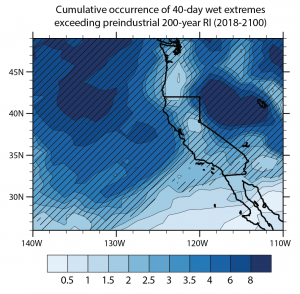
Between December 1861 and January 1862, the nascent state of California experienced a truly extraordinary meteorological event: a more than 40-day long onslaught of extremely moist “atmospheric river” storms that led to widespread inundation on a massive scale. Newspaper reports and personal journals suggest that nearly every river, stream, and creek between central Oregon and the Mexican border experienced significant flooding during this event, which brought dozens of inches of rain even to California’s drier low-lying coastal areas over the course of just a few weeks, and well over 100 inches of rain (over 8 feet) along the western slopes of the Sierra Nevada over a two month period. The Central Valley was transformed into a 25-mile wide, 300-mile long inland sea as deep as 20 feet in some places; newly-elected governor Leland Stanford was transported to his January inauguration at the state capitol via rowboat through the streets of Sacramento shortly before the state legislature made the decision to temporarily relocate to San Francisco. Vast swaths of land in Los Angeles and Orange counties were underwater—land that is now heavily urbanized, and home to millions of Californians. (For those interested, I highly recommend this excellent long read on the 1862 flood event, as well as this earlier piece in Scientific American.)
The U.S. Geological Survey, in a landmark report published in 2011, termed a modern repeat of a similar extreme storm sequence California’s “Other Big One”—an indication that the impact of such an event would be comparable to the enormous damages wrought by a large-magnitude earthquake near San Francisco or Los Angeles. It’s not difficult to see why the “ARkStorm” scenario would be devastating in present-day California: the state is now home to nearly 40 million more people than it was in 1862, nearly a quarter of whom live in floodplains that would be inundated during an event of this magnitude. California today depends on an enormously extensive water storage and distribution system to satisfy agricultural irrigation demands in the Central Valley and urban water needs in its thirsty coastal cities; many of the levees and dams that make up this vast water network also serve as flood control structures that protect urban areas from rising waters during storm events. All of California’s major economic sectors—from Silicon Valley tech to Hollywood movie production to large-scale agriculture—could grind to a virtual standstill in the aftermath of such an event. Overall economic damages could approach a trillion dollars, and thousands of lives would be at risk.
This all may sound pretty implausible, like something out of a disaster movie. But the underlying physical event (a 40+ day sequence of extreme storms) is not a theoretical construct—it definitely happened in 1862. And paleoclimate analysis of sediments from California’s coastal river systems suggests that events of a similar magnitude have happened many times in the region’s deeper past—approximately every 200 years. But how will the odds of such a potentially catastrophic event change as the climate warms?
Our new analysis suggests that the risk of an extreme “sub-seasonal” 40-day precipitation event similar in magnitude to that which caused the 1862 flood will rise substantially as the climate warms. By the end of the 21st century, we find a 300 – 400+ % increase in the relative risk of such an event across the entire state. One specific statistic that my colleagues and I found particularly eyebrow-raising: on our current emissions trajectory, at least one occurrence of an 1862-level precipitation event is more likely than not over the next 40 years (between 2018 and 2060), with multiple occurrences plausible between now and the end of the century. In practical terms, this means that what is today considered to be the “200-year flood”—an event that would overwhelm the vast majority of California’s flood defenses and water infrastructure—will become the “40-50 year flood” in the coming decades.
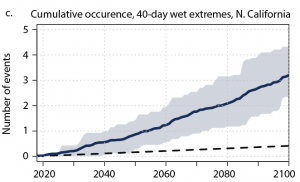
An even shorter, sharper rainy season
Warm, dry summers and mild but (usually) wet winters are deeply engrained in the ecology and ways of life of the Golden State. And fortunately, that general “dry summer, wet winter” seasonality is not expected to change drastically as the climate warms. But our new research builds upon previous findings that California’s already short, sharp rainy season is likely to become even shorter and sharper during the twenty-first century. We find that the core rainy season months of December-February will typically be wetter than their 20th century counterparts, but that precipitation during the “shoulder season” (i.e., the autumn months of September-November and the spring months of March-May) will typically be drier than in California’s historical past. We find a future increase in “seasonal sharpness” of anywhere from 30% (in far Northern California) to 80% across portions of Southern California. And while we don’t focus on observed trends in this paper, we do find that an increase in seasonal sharpness (driven mainly by decreasing autumn and spring precipitation) has already started to emerge across much of California in recent years—especially in the south.
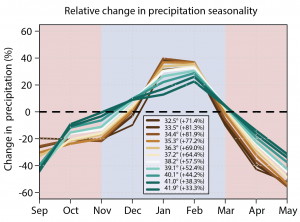
In late 2017, Southern California received a devastating lesson in why a delayed onset of the winter rainy season—as is projected to occur much more often in a warming climate—can have tremendous consequences. The enormous Thomas Fire in Ventura and Santa Barbara Counties, which burned nearly 300,000 acres and became California’s largest wildfire in modern history, was pushed by relentless, warm and dry Santa Ana winds in December. While Santa Ana winds are not unusual in December, the antecedent record warmth and near-record low autumn precipitation allowed vegetation to remain at summer-like dryness well into what would typically have been the rainy season. It’s unlikely that the Thomas Fire would have become the regional catastrophe it ultimately did had the region received significant rainfall during October-November.
Increasing climate whiplash will be serious challenge in 21st century California
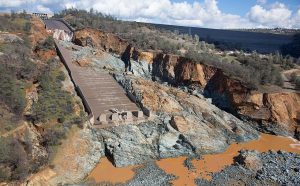
With a large projected increase in the occurrence of both extreme wet and extreme dry events, a new question arises: will California experience more sudden transitions between the two extremes? Our research suggests that the frequency of such “precipitation whiplash” events—in which California experiences a very dry year followed immediately by a very wet year—will increase considerably as the climate warms. We find anywhere from a 25% increase in far northern California to over a 100% increase over far southern California in the frequency of these dry-to-wet whiplash events (of a magnitude that has historically occurred about four times per century). We also consider the month-to-month variability of precipitation within the rainy season itself—and find a significant increase in precipitation whiplash on sub-seasonal timescales, as well. In other words: California will likely experience more frequent jarring transitions between dry and wet years, but also between dry and wet months within individual years.
While our research focuses primarily on projected changes over the coming decades, other recent studies have offered compelling evidence that many of these changes are already underway. An increase in the frequency of extremely both extremely wet and extremely dry years in California has recently begun to emerge in the observational record, and there is preliminary evidence that precipitation whiplash has started to increase across a broad swath of the western United States. Our findings regarding a 3- to 4-fold increase in the projected risk of an 1862-like flood event parallel similar insights into the rising risk of a Hurricane Harvey-like catastrophic flood event along the Gulf Coast. While the physical mechanisms of extreme precipitation due to landfalling tropical cyclones (as occurred in Houston during Harvey) are quite different from that resulting from a persistent sequence of atmospheric river storms (as occurred in California during the 1862 flood), they both share a common factor: both processes act to locally concentrate atmospheric water vapor, which is increasing at an exponential rate as the atmosphere warms. The climate model simulations we use in our work generally predict that a robust “signal” for increased likelihood of these really extreme wet and dry events will most likely emerge from the “noise” of natural climate variability sometime close to the present decade (2015-2025)—which is entirely consistent with the nascent real-world hints of such an increase.
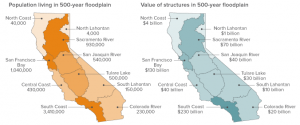
It’s worth noting that we don’t consider the effect of rising temperatures themselves in this paper. Other scientists have demonstrated that Sierra Nevada snowpack is now in decline, which has serious implications not only for California’s water resources and higher-elevation ecosystems but also for flood risk. Higher snow lines mean that more precipitation immediately turns into runoff during storms, resulting in higher flows on rivers and more intense inflows into reservoirs (with greater stresses on levees, dams, and other flood control structures). This trend toward rain (at the expense of snow) will likely have a “double whammy” effect, amplifying the increased flood risks associated with more extreme precipitation events. And as noted above, expected large future increases in California drought risk will be driven primarily by increasing temperatures; the projected increase in extremely low precipitation years will only add to this risk. Together, these rather profound hydroclimatic changes will likely pose a progressively escalating series of tests upon California’s existing water infrastructure.
Is it really all doom and gloom? Some personal thoughts from a climate scientist.
As a lifelong Californian—and as a person who grew up watching California storms and droughts and wildfires, and turned that fascination into a formal path of scientific inquiry—I will admit that it’s more than a little disconcerting to report plausible future changes as drastic as the ones we find in our research. Climate scientists are sometimes accused of being “alarmist,” but I would argue that alarm is a reasonable human response to recent climate science data. As a scientist, I feel a personal responsibility to have honest conversations about the broader societal implications of the rapid changes in climate unfolding within our lifetimes—and sometimes, the news isn’t pretty.
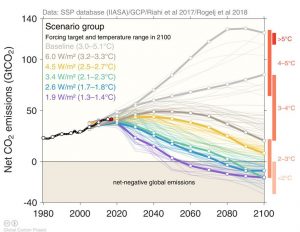
But is it really all doom and gloom? I’d like to offer a few bright spots for consideration. First: all the results discussed in this post are predicated on a hypothetical “business as usual” carbon emissions trajectory that exhibits continued growth in the coming decades. It is most likely (as I and other scientists sincerely hope) an overly pessimistic scenario, but it is also the trajectory that most closely parallels our still-increasing global carbon emissions. Fortunately, there are quite a few reasons to believe that our real-world emissions trajectory will eventually fall below this business-as-usual path. While many of the same changes in California climate extremes would likely still result from a lower carbon emissions trajectory, the magnitude of the changes would be considerably reduced. For quite some time, the biggest uncertainty in climate science has been how we, as a society, choose to respond to this growing global threat. The optimistic view: there is still time for us to take bold, decisive actions that will shape our planet for decades (and even millennia) to come.
And even though a considerable degree of additional global warming—along with substantial further increases in global climate extremes—is an essentially inevitable consequence of greenhouse gases already emitted and the enormous inertia of our carbon-intensive modern society, there is much we can do to mitigate these foreseeable risks. California has long been a pioneer of novel and strategic adaptations to its intrinsic climate of extremes, and there’s plenty of reason to believe that the Golden State will continue to be a leader in climate solutions. A California resilient to increasing 21st century climate whiplash won’t emerge overnight, but we now know enough about our plausible climate future to make informed decisions.
How is this article different from typical Weather West blog posts?
This special Weather West article focuses on peer-reviewed scientific research by my colleagues and I that has recently been published in Nature Climate Change, and also discusses peer-reviewed work by other scientists. This means that the discussions in this piece are based upon findings from formal investigations by teams of researchers, which contrasts with more typical California Weather Blog posts that are primarily based upon my own informal thoughts and analysis. I would like to thank my co-authors in this work—Baird Langenbrunner, David Neelin, and Alex Hall—for their invaluable support in bringing this project to completion. Funding for this research was provided by the UCLA Grand Challenge and by the Nature Conservancy through a partnership with UCLA via the NatureNet Fellows program.
An open-access read-only version of the paper (freely accessible to all!) can be viewed here. A full version of our paper can be found here.
A web-sharable infographic illustrating key points from our precipitation whiplash work can be found here. I’d like to thank science communicator Katharine Reich and graphic designer Rebecca Hume for making this possible!
Citation: Swain, D. L., B. Langenbrunner, J. D. Neelin, and A. Hall, “Increasing precipitation volatility in 21st-century-California,” Nature Climate Change, doi:10.1038/s41558-018-0140-y, 2018.
Increasing precipitation whiplash in twenty-first century California Read More »
